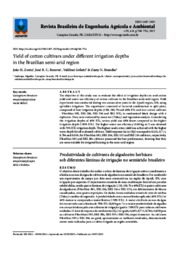Yield of cotton cultivars under different irrigation depths in the Brazilian semi-arid region.
Yield of cotton cultivars under different irrigation depths in the Brazilian semi-arid region.
Author(s): ZONTA, J. H.; BEZERRA, J. R. C.; SOFIATTI, V.; BRANDAO, Z. N.
Summary: The objective of this study was to evaluate the effect of irrigation depths on seed cotton yield and water-use efficiency of cotton cultivars in the Brazilian semi-arid region. Field experiment was conducted during two consecutive years in the Apodi region, RN, using sprinkler irrigation. The experiment consisted of factorial combination in split-plots, composed of four irrigation depths (130; 100; 70 and 40% ETc and four cotton cultivars - FiberMax 993, BRS 286, BRS 336 and BRS 335), in randomized block design with 4 replicates. Data were evaluated by mean test (Tukey) and regression analysis. Considering the irrigation depths of 40% ETc, cotton yield was 48% lower compared to the higher irrigation depth (130% ETc). The higher water-use efficiency (0.69 kg m-3) was obtained with 70% ETc irrigation depth. The highest seed cotton yield was achieved with the higher water depth for all evaluated cultivars. Yield response factor (Ky) was equal to 0.632, 0.711, 0.784 and 0.858, for FiberMax 993, BRS 286, BRS 335 and BRS 336 cultivars, respectively. FiberMax 993 and BRS 286 cultivars presented the best performance, showing that they are more suitable for irrigated farming in the semi-arid region.
Publication year: 2015
Types of publication: Journal article
Unit: Embrapa Cotton
Observation
Some of Embrapa's publications are published as ePub files. To read them, use or download one of the following free software options to your computer or mobile device. Android: Google Play Books; IOS: iBooks; Windows and Linux: Calibre.
Access other publications
Access the Agricultural Research Database (BDPA) to consult Embrapa's full library collection and records.
Visit Embrapa Bookstore to purchase books and other publications sold by Embrapa.

